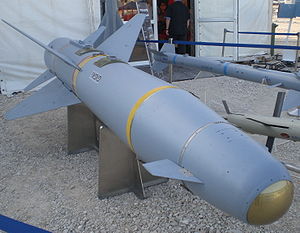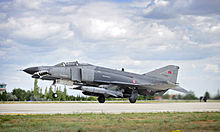Popeye (missile)
| Popeye | |
|---|---|
 The "Popeye" standoff missile | |
| Type | Air-to-surface missile SLCM |
| Place of origin | Israel |
| Service history | |
| In service | 1985–present |
| Used by | SeeOperators |
| Production history | |
| Designer | Rafael Advanced Defense Systems |
| Manufacturer |
|
| Specifications | |
| Mass | 1,360 kg (3,000 lb) |
| Length | 4.82 m (15 ft 10 in) |
| Diameter | 533 mm (21.0 in) |
| Wingspan | 198 cm (78 in) |
| Warhead | 340 kg (750 lb) blast fragmentation or 360 kg (790 lb) I-800 penetrating |
| Engine | Single-stageSolid-fuel rocket |
Operational range | 78 km (48 mi) |
Guidance system | Inertial plusIIRor TV |
Launch platform | Fixed-wing aircraft, Dolphin class submarine (Popeye Turbo SLCM) |
ThePopeye(Hebrew:פופאי) is a family ofair-to-surface missilesdeveloped and in use by Israel, of which several types have been developed for Israeli and export users. A long-rangesubmarine-launched cruise missilevariant of the Popeye Turbo has been speculated as being employed in Israel's submarine-based nuclear forces.[1]The United States operated the Popeye under a different designation according to US naming conventions as theAGM-142 Have Nap.
Design
[edit]The Popeye is designed for precision attack against large targets fromstand offranges. The standard Popeye and smaller Popeye-Lite are powered by a single-stagesolid rocket.Rafael offered a Popeye Turbo air launched variant featuring a jet engine and folding wings for a UK competition specifying a cruise missile with range of at least 320 km (200 mi) in 1994; publicly exposing a lowest possible maximum range for that variant.[2][page needed]Aninertial guidance systempilots the missile towards the target; for terminal homing the pilot can control the missile directly via an INS anddata link,aiming via either atelevisionor imaging infrared seeker depending on the missile model. It is not necessary for the launching aircraft to direct the missile—control can be passed to another platform while the firing aircraft escapes the area. There are two choices of warhead for the export versions, a 340 kg (750 lb) blast/fragmentation or 360 kg (790 lb) penetrator.
The alleged Israelisubmarine-launched cruise missilevariant is reported to be jet powered and nuclear armed with a greatly increased range, though according to theFederation of American Scientists"open literature provides little information on this system" but in a May 2000 test launch was tracked for 1,500 km (930 mi).[1]
Air launched variants
[edit]- Popeye(also known asHave Nap)— standard solid-rocket–powered stand off missile, 4.82 m (15 ft 10 in) long and weighing 1,360 kg (3,000 lb) with a 340 kg (750 lb) blast fragmentation or 360 kg (790 lb) I-800 penetrating warhead, inertial and imaging infrared or TV guidance.[3]
- Popeye IIorPopeye Lite(also known asHave Lite)— reduced size (shortened to 4.24 m [13 ft 11 in]) and weight version (weight is now 1,125 kg [2,480 lb]) of the Popeye to give light aircraft such as theF-16I Sufaa precision standoff strike capability.[3]
- Popeye Turbo ALCM—The Popeye Turboair-launched cruise missile,which uses a jet engine and liquid fuel, is approx 6.25 m (20 ft 6 in) long; it is reported to have a range of more than 320 km (200 mi).[4]
- Crystal Mazeor Raptor was developed in 2003–2004 to be lighter than Popeye for India, with a range of 100 km (62 mi), weighting 1,100 kg (2,400 lb) and carrying an 80 kg (180 lb) warhead.[5]
- Crystal Maze IIor ROCKS is an improved version of Crystal Maze with an enhanced range of 250 km (160 mi). The missile was first test launched in April 2024 fromSukhoi Su-30MKIunderAndaman and Nicobar Command.The missile will be mass manufactured in India forIndian Air Force.The missile has the capability to target long range radars and air defence systems inGPSdenied environments.[6][7][8]
- Have Rain—A 2004 report indicated that Rafael was developing a new anti-ship version known as the “Have Rain.” The new missile is believed to have a launch weight of 900 kg (2,000 lb), for deployment aboardLockheed P-3 Orion.[9]
- Spice:In 2000, Rafael promoted a "Smart Precise Impact Cost Effective" (Spice) add-on "smart bomb" guidance kit for Mk 84 bombs, this system was based on the Popeye seekers.[3]
Popeye Turbo Submarine Launched Cruise Missile
[edit]The Popeye Turbo SLCM is a reportedly stretched version of the Popeye Turbo developed for use as asubmarine-launched cruise missile(SLCM), which was widely reported – in a US Navy-observed 2002 test in the Indian Ocean – to have hit a target 1,500 km (930 mi) away. It is reasonable to assume that the weapon's range has been extended to the point where it can launch against Tehran and even more Iranian cities from a relatively safe location.[10]It can allegedly carry a 200kilotonnuclear warhead.[10]It is believed that the stretched Popeye Turbo is the primarystrategic second strikenuclear deterrentweapon that can be fired from the 650 mm (26 in) secondary torpedo tubes of the IsraeliDolphin-class submarines.[1]It is believed that the SLCM version of the Popeye was developed by Israel after the US Clinton administration refused an Israeli request in 2000 to purchaseTomahawklong rangeSLCMbecause of internationalMTCRproliferation rules.[11]While the standard Popeye is 533 mm (21.0 in) theDolphinclass submarines have four 650 mm (26 in) torpedo tubes in addition to the six standard 533 mm (21.0 in) tubes allowing for the possibility that a SLCM Popeye derivative may be a larger diameter.[12]
Overview
[edit]The Popeye is compatible with a variety of aircraft from tactical fighters to heavy bombers.[13]
Since their inception, the missiles have gone through a variety of improvement programs designed to increase reliability and reduce costs. These efforts have included changes in the materials and manufacturing processes of the wings, fins and rocket motor, new components in the inertial guidance unit, an upgraded processor, and an improved imaging infrared seeker.
Israel is thought to be using the airframe and avionics to produce a long-range submarine-launched cruise missile with a liquid-fueled jet engine similar to the Popeye Turbo rather than a rocket.[14]
In US use, the Popeye designated as the AGM-142 Have Nap is intended primarily to equip theB-52H,allowing it to attack fixed targets of high value at sufficient range to provide protection from defences. The missile represented the first precision guided munition to be carried by the B-52H.
The LondonSunday Timesnewspaper reported that on 5 July 2013, Israeli Dolphin submarines fired long-range cruise missiles at stores of Russian-madeP-800 Oniksanti-ship missiles kept at the Syrian port ofLatakia,contradicting an earlier CNN report it had been an air strike.[15]Israel also deploys sub-Harpoon missiles capable of land attack on its Dolphin class submarines.[16]
In the afternoon of 7 December 2014, two formations composed by two Israeli Air ForceF-15Iseach,fired Popeye missiles against two separate target sites in Syria.Syrian air defenseBuk-M2missile batteries fired two missiles at the incoming attack planes, both werejammedand twoPechora 2Mmissiles were hastily launched at the four incoming Popeye missiles, shooting one down.[17][unreliable source?]
In the early hours of 30 November 2016, Israeli planes launched air-to-surface Popeye missiles from Lebanese airspace at targets at Sabboura, north-east of Damascus.[18]
Deployment
[edit]
First developed for use by theIsraeli Air Force,it has been in service since 1985.
The United States Air Force first bought a batch of 154 missiles in 1989 followed by a second batch of 54 missiles in 1996.
TheRoyal Australian Air Forcepurchased a number of Popeye missiles in the late 1990s for use by the RAAF'sF-111bombers. The F-111 was taken out of Australian service in 2010.[19]It proved difficult to integrate the missiles onto the F-111s and costs were much higher than expected.[20]
Currently, theTurkish Air Force'sF-4 2020 Terminatoraircraft (which were extensively upgraded byIAI) and the TuAF F-16 CCIP are armed with a Turkish License production version of the Popeye.
Israel and Turkey co-production
[edit]In May 1997, Israel and Turkey signed an agreement valued in excess ofUS$500 million for the establishment of a joint-venture between Israel's Rafael and Turkey'sTurkish Aerospace Industriesfor the co-production of Popeye I and Popeye II missiles in Turkey.[13]
Operators
[edit]

There have been reports that Israel has exported Popeye and its variants to various countries:[21][22]
 Australia:Royal Australian Air Force
Australia:Royal Australian Air Force India: 30 forIndian Air Force
India: 30 forIndian Air Force Israel:Israeli Air Force,Israeli Navy
Israel:Israeli Air Force,Israeli Navy South Korea:Republic of Korea Air Force(retired in 2024)
South Korea:Republic of Korea Air Force(retired in 2024) Turkey:Turkish Air Force
Turkey:Turkish Air Force United States:United States Air Force(retired in 2004)
United States:United States Air Force(retired in 2004)
Specifications
[edit]- Weight:1,360 kg (3,000 lb)
- Length:4.82 m (15 ft 10 in)
- Diameter:533 mm (21.0 in)
- Wingspan:1.98 m (6 ft 6 in)
- Guidance:Inertial plus imaging infrared or TV
- Engine:Single-stage solid rocket
- Range:78 km (48 mi)
- Warhead:340 kg (750 lb) blast fragmentation, or 360 kg (790 lb) I-800 penetrating
See also
[edit]References
[edit]- Citations
- ^abcIsraeli missile.FAS
- ^NTI.
- ^abc"Cruise".Missile threat.Archived fromthe originalon 2009-10-14.Retrieved2012-08-25– viaPortuguese Web Archive.
- ^"Emerging Biocruise Threat".AF.USAF Counterproliferation Center.
- ^"Popeye".Missile Threat.CSIS.Retrieved2020-03-19.
- ^"India successfully tests new 250 km strike range air-launched ballistic missile".India Today.2024-04-23.Retrieved2024-04-24.
- ^"IAF successfully tests air-launched ballistic missile in Andamans, significantly boosts stand-off capabilities".The Economic Times.2024-04-23.ISSN0013-0389.Retrieved2024-04-24.
- ^"India successfully tests Crystal Maze-2 missile capable of striking targets up to 250 kilometres away".WION.2024-04-23.Retrieved2024-04-24.
- ^Pike, John."AGM-142 Raptor / Have Nap / Popeye - Smart Weapons".Global security.Retrieved8 October2015.
- ^abMizokami, Kyle (6 December 2017)."Israel Has a Submarine That Could Destroy Entire Nations (Armed with Nuclear Weapons)".National interest.
- ^"Submarine Proliferation - Israel Current Capabilities".Nuclear Threat Initiative. Archived fromthe originalon July 4, 2007.RetrievedJuly 29,2017.
- ^"SSK Dolphin Class Submarine".Naval Technology.Retrieved8 October2015.
- ^ab"AGM-142 Raptor / Have Nap / Popeye - Smart Weapons".Retrieved8 October2015.
- ^John Pike."Popeye Turbo".Retrieved8 October2015.
- ^Ben Hartman (14 July 2013)."Report: Israeli submarine strike hit Syrian arms depot".The Jerusalem Post.Reuters.Retrieved23 March2014.
- ^John Pike."AGM-84 Harpoon/SLAM - Smart Weapons".Retrieved8 October2015.
- ^War Is Boring (12 December 2014)."Four Israeli F-15s Dodged Syrian Missile Fire to Attack Urgent Targets — War Is Boring".Medium.Retrieved8 October2015.
- ^"Syria conflict:Israeli jets strike outside Damascus".BBC News.30 November 2016.Retrieved1 December2016.
- ^Dodd, Mark (3 December 2010)."RAAF puts F-111 out to pasture".The Australian.Archived fromthe originalon December 3, 2010.
- ^La Franchi, Peter (19 May 2000)."Missile costs blow out to $395m".Australian Financial Review.Retrieved27 April2024.
- ^"Israel".NTI.Archived fromthe originalon 9 February 2016.Retrieved25 August2012.
- ^"Popeye-2".Missile threat. Archived fromthe originalon 13 August 2007.Retrieved25 August2012.
- Bibliography
- Bonds, Ray and David Miller (2002).Illustrated Directory of Modern American Weapons.Zenith Imprint.ISBN978-0-7603-1346-6.[permanent dead link]
